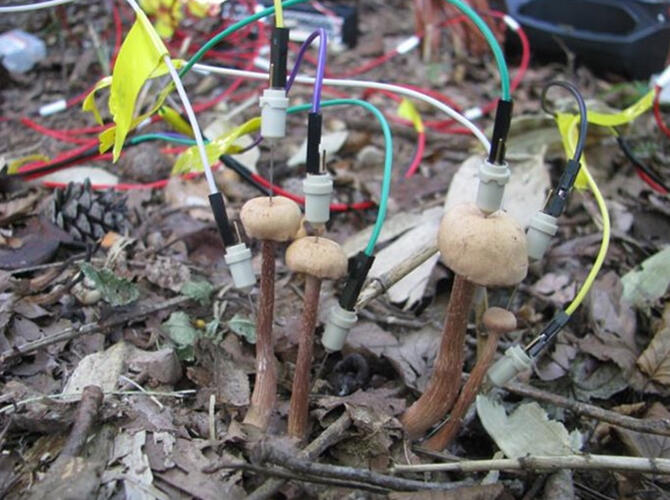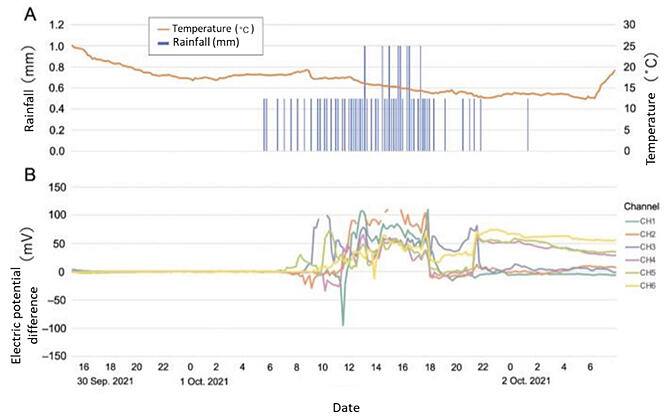Mushrooms may exchange information with each other after rain occurs. A research group consisting of Assistant Professor Yu Fukasawa of the Graduate School of Agricultural Science, Tohoku University, Lecturer Takayuki Takehi, undergraduate student Daisuke Akai of the National Institute of Technology (KOSEN), Nagaoka College and Associate Professor Masayuki Ushio of the Hakubi Center, Kyoto University (currently Assistant Professor at the Department of Ocean Science, the Hong Kong University of Science and Technology) attached electrodes to the ectomycorrhizal (symbiotic) fungus Laccaria bicolor emerging from the forest ground and measured the changes in as well as the maintenance of the mushroom's electrical activity under field conditions after the rain had occurred. A significant causal relationship was observed in the pattern of electrical potential fluctuations among mushrooms, suggesting that electrical signal transport occurs among mushrooms. Their research results were published in the online edition of Fungal Ecology.

Provided by Tohoku University
Ectomycorrhizal fungi play important roles in maintaining forest ecosystems by establishing symbiotic relationships with plant roots through a network of hyphae (branching filaments of fungi) created in the soil. Although signal transfer among plants via ectomycorrhizal hyphae has attracted public attention, scientific data on the subject remain limited.
Electrical signals are used to transport signals in all organisms, not just those with nervous systems. Even in fungi, electrical potentials and signal transport among mushrooms have recently been measured in the hyphae of mushrooms in laboratories; however, these measurements had not been performed in the field.
The research group attached electrodes to six individuals of the ectomycorrhizal fungus L. bicolor emerging from the forest ground and obtained field data that suggested the presence of electrical signal transport in fungi for the first time. Immediately after attaching the electrodes to the fungi, a very low electrical potential was measured. However, during the two‐day measurement, rainfall occurred, and a short time after the rain, the electrical potential of the fungi began to show large fluctuations, and electrical potential activity was maintained after the rainfall.
Causal analysis based on the time‐series data was performed using the data obtained when the electrical potential had stabilized after the rain. A significant causal relationship was observed in the potential‐fluctuation pattern among fungi. The causal relationship was stronger between spatially close fungi and showed potential directionality. For example, a change in the electrical potential of fungus 1 affected fungus 2 after approximately 1 second, whereas several seconds were required for the electrical potential of fungus 2 to affect fungus 1. This suggests that electrical signals are transported among mushrooms and that this signal transport is directional. Ectomycorrhizal fungi produce mushrooms above ground and have a network of hyphae underground. The findings of the group suggest that ectomycorrhizal fungi transport electrical signals through underground hyphae.

Provided by Tohoku University
These results indicate that fungi transport signals through a network of hyphae even in the field. Ectomycorrhizal fungi connect individual plants by forming a network of hyphae in the soil and establishing symbiotic relationships with the roots of many individual plants. Studies are needed to determine the ecological roles of fungi, such as signal transport between individual plants through ectomycorrhizal fungi.
This article has been translated by JST with permission from The Science News Ltd. (https://sci-news.co.jp/). Unauthorized reproduction of the article and photographs is prohibited.




